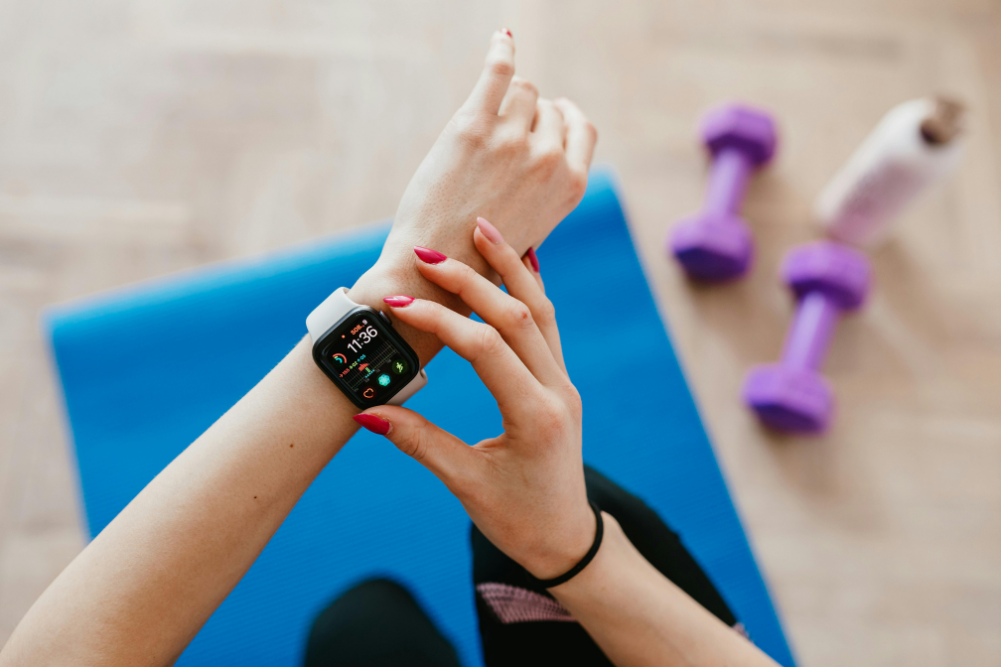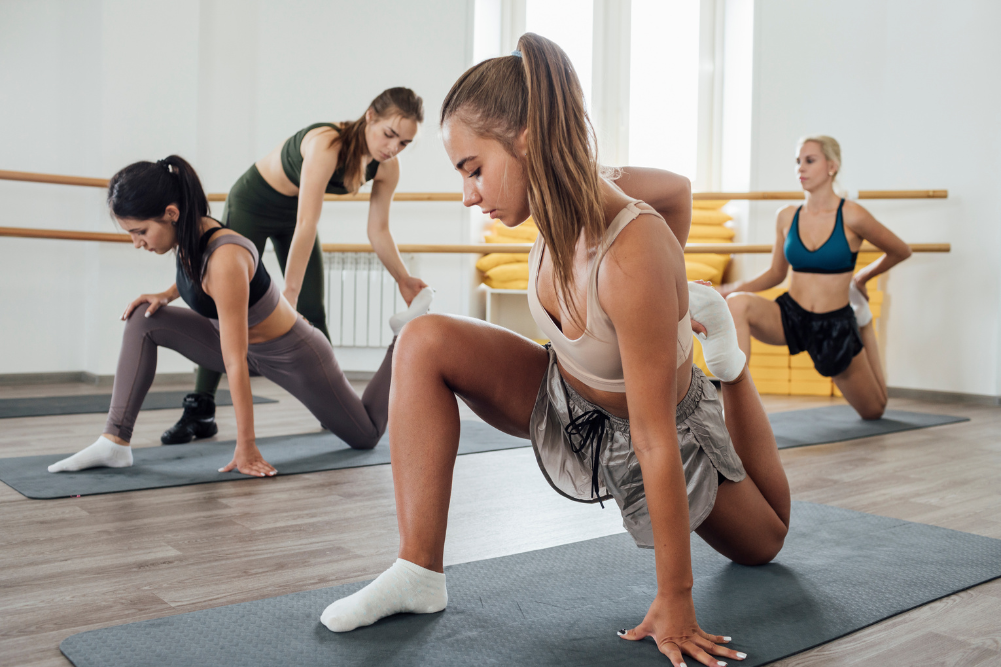Is resistance training for you?
Strength training may once have been viewed only as a training method for male bodybuilders but, these days, average male and female exercisers are realising its importance for healthy bones, muscles and ageing. Strength training always uses resistance of some form so can also be called resistance training. The resistance may be a weight you are trying to lift or it might be your own bodyweight, as in a push-up or squat. Whatever the method, resistance training will be anaerobic in nature.
Aerobic means “with oxygen” while anaerobic means “without oxygen”, but there is more to it than simple linguistic distinction. When performing a set of aerobic exercises you are causing the body to utilise oxygen to create energy. The oxygen is needed to break down glucose, which is the fuel needed to create energy. However, the opposite applies to anaerobic exercise. In anaerobic exercise the body creates the energy without oxygen because there is not enough oxygen present and so it ends up burning fuel other than glucose — like fat.
Studies have told us that anaerobic exercise will burn between five and seven times more kilojoules than the same amount of aerobic exercise. Aerobic exercise will burn 25 per cent muscle and 75 per cent fat, while anaerobic exercise will burn 100 per cent fat.
Anaerobic exercises use resistance, so you will also be building muscle and bone as an added benefit. Aerobic exercise will have more of an impact on the cardiovascular and circulatory systems. Combining the two gives the greatest health benefits but resistance exercise is emerging as providing an array of health benefits.
The value of resistance
Obviously, resistance training will build muscle, but the benefits go far beyond simply looking good in a T-shirt. Juliette Cassidy is a personal trainer and co-owner of ZULU Fitness based on the Central Coast in NSW. Cassidy says, “Weight training offers so much to a person wanting to get fit. It increases strength, it increases power and it helps with weight loss by firing up the metabolism and boosting lean muscle mass. In addition to that, it will build bone density and that all adds up to improved sports performance.”
There is more, though, than just physical benefits to be had from working out with weights. Brendan Dews is a personal trainer with a degree in sports science. He works out of Cronulla Fitness Club and is co-owner of Stand Up Paddle Surfing Australia. According to Dews, “Some interesting benefits of resistance training include protecting joints from injury with more muscle, helping maintain balance as you age, increasing your sense of wellbeing and even boosting self-confidence through improved body image.”
Before we look at how to get started on your resistance exercise program let’s delve a little deeper into what the research says resistance exercise will do for you.
Arthritis relief
You might expect that lifting weights or even doing squats would put strain on joints and aggravate conditions such as arthritis but, in fact, the reverse seems to be true. Resistance training appears to improve muscle strength and physical function and decrease pain in people who suffer from osteoarthritis of the knee.
In one study, mostly overweight and obese men and women aged from 55 to 74 participated in resistance programs of regular, repetitive exercise using free weights, resistance bands or resistance machines for one to six months, on average. Resistance training was found to potentially counteract the functional limitations caused by osteoarthritis of the knee.
Another study that focused on knee arthritis suggested it was greater strength in the muscles of the thigh that helped reduce arthritis pain. In that study, greater quadriceps strength at the beginning of the study seemed to protect people against loss of cartilage behind the kneecap, with individuals in the top third for quadriceps strength at 60 per cent lower risk of losing cartilage. People with stronger quadriceps also had better physical function and less knee pain.
These two studies are by no means isolated. A review of available research done on resistance training and arthritis found that in 56 per cent of the studies reviewed, resistance training participants reported improvements in pain, muscle strength and mobility. In 75 per cent of the studies the researchers identified clinically meaningful improvements in physical function and strength among people who used resistance training.
Hearts love resistance
Resistance exercise produces a different pattern of blood vessel responses from aerobic exercise, suggesting it may have specific and important benefits for cardiovascular health.
In one study, researchers compared blood vessel responses to two different types of moderate-intensity exercise: a set of eight resistance exercises, including three sets of 10 repetitions or 30 minutes of aerobic cycling. The researchers measured blood-vessel widening in response to increased blood flow and arterial stiffness. Resistance exercise produced greater increases in blood flow to the limbs, even though it also caused small increases in central arterial stiffness. Aerobic exercise produced a decrease in arterial stiffness but without an increase in blood flow. Resistance exercise also led to a longer-lasting drop in blood pressure after exercise than did aerobic exercise.
Arterial stiffness of major blood vessels such as the carotid arteries and aorta is a risk factor for heart disease. The results of this study show that resistance exercise has unique effects, especially because of its ability to increase blood flow to active muscles.
Shedding bellies
Fat is no fun wherever it is but some fat is even less fun than other fat. Subcutaneous fat is the fat that collects in the layers just under your skin. While subcutaneous fat might not be too attractive, it is not as dangerous to your overall health as visceral fat, which is the fat deep in your belly that collects around your organs. The good news is that resistance exercise can help shift that visceral belly fat.
This was verified when researchers randomly assigned 164 women between 25 and 44 who were overweight or obese into two groups. One group received standard care in which they were given diet information and instructions to exercise moderately to vigorously for 30 minutes on most days of the week. The second study group received strength training under the supervision of a certified professional. This strength training involved exercising all the large muscles, the quads and hamstrings, the pectorals and the upper and lower back. The deltoids, biceps and triceps were also exercised. At the beginning of the study, all of the women underwent CT scans of the abdominal area to measure visceral fat.
After two years, there was no difference in bodyweight between the groups but visceral fat increased by only 6.3 per cent in the strength-training group compared with an increase of 20.1 per cent in the control group.
Weighty hormone impact
Resistance exercise favourably impacts on hormone levels in your body. A study of men in their 20s, 60s and early 70s had the men perform a strength endurance resistance exercise program of six exercises that included seated chest press, pec deck (prone chest presses), lateral pulldowns, biceps curls, leg extension and leg flexion. At each exercise, the men performed three sets of 15 reps with a 90-second rest period between sets. The researchers measured testosterone, cortisol and growth hormone levels before exercise, immediately after exercise and 15 minutes after the end of exercise.
They found that strength training boosted metabolism, as evidenced by increased blood lactate concentrations in both younger and older men, with the highest increases seen in the younger men. In addition, testosterone and cortisol concentrations were markedly higher immediately after and then 15 minutes after strength training, relative to pre-exercise concentrations, in both younger and older men. Growth hormone levels also rose after resistance training in both age groups, although the increase was higher in the younger men.
Resistant to ageing
Anti-ageing is big business these days as people seek ways to live not only longer but also better. The evidence certainly suggests that, for your body and your mind, resistance training has a lot to offer.
The mitochondria are the energy generators within your cells. Mitochondrial breakdown is one of the mechanisms believed to drive the ageing process. As muscles get older and weaker, the mitchondria inside their cells show increasing evidence of dysfunction. Mitochondrial dysfunction is measured by counting the number of mistakes they make when they transcribe their DNA code to make essential materials such as proteins. A transcription profile is a measure of how well your mitochondria are working. To test the effect of resistance exercise on mitochondria, researchers took two groups of male and female volunteers. One group consisted of adults aged from 20 to 35 years and the other was made up of adults over 65.
At the start of the study, they took skeletal muscle biopsies from both groups, from which they were able to assess their transcription profiles. They also tested their muscle strength. The older adults then completed a 26-week whole-body resistance exercise-training program based on stretching and weight-bearing exercise on gym equipment that involved three sets of 10 repetitions for each muscle group, including, for instance, leg press, chest press, leg extension, leg flexion, shoulder press and lat pulldown. The sessions lasted one hour and took place twice a week.
Not surprisingly, the older adults increased their strength but more interesting was what happened to their transcription profile. Before the exercise program, the older adults had mitochondrial transcription profiles consistent with the deterioration we have come to accept with ageing, but after the program, they became more like the transcription profiles of the young adults. The results strongly supported the notion that mitochondrial dysfunction is linked to ageing in humans. The exciting finding is that resistance training reverses many aspects of this.
The anti-ageing qualities of resistance are also more than physical. Studies have shown that resistance training boosts cognitive function in older people. People with stronger grips who have maintained their strength are also shown to live longer than people who let their strength wane. So if a long, good life is your aim, resistance training is a must.
Mmmmm, muscles!It may not be the most noble of motives after all this talk of promoting health through building muscles but it seems that women do prefer muscular men. Research reveals that muscular young men are likely to have more sex partners than their less-chiselled peers. Muscles in men are like elaborate tail feathers in male peacocks: they attract females looking for a virile mate. Source: Personality and Social Psychology Bulletin |
How to do it
So, based on what you now know you have decided that you definitely want to use resistance training as part of your fitness routine. However, as with most things, you can’t just jump straight into doing a weights program if you haven’t prepared properly, or injury and dissatisfaction are sure to follow.
Both Juliette Cassidy and Brendan Dews say your best way to start resistance training is to book a session with a personal trainer. Sure, they are personal trainers and they would say that, wouldn’t they?! Yet, as Dews points out, “A trainer will design a program based on your exercise background, the time you have available, your injury history and interests. You will be guided through a program showing you how to train safely and effectively.”
So, once your baseline has been set, you are ready to start on your resistance training. According to Dews, “For a general resistance program, two to three sets of eight to 12 repetitions is the norm per exercise. You may do one to three exercises per muscle group, but one exercise per big muscle group is fine to begin with. Big-muscle exercises that mirror functional movements are more productive than small-muscle, isolated movements. For example, big movements such as squatting, pulling and pushing are going to work you harder than an arm curl. Aim for doing a session two to three times a week, optimally giving the muscles a rest day in between using the same movements again. The body needs rest to recover, adapt and grow.”
Of course, once you are engaging in regular resistance training, your capacity to lift greater weights will increase. “If your workout starts feeling too easy and you are performing the sets and reps without getting out of breath or feeling fatigued, then you are ready to progress to a heavier weight,” says Cassidy. “The progression should be in small increments, adding one or two kilograms in weight. If you started out doing squats and lunges without any added weight to your own bodyweight, you might add a 2kg dumbbell in each hand for those exercises. Adding more reps to your push-ups or trying to get your chest all the way to the floor, and increasing the depth of the push-up, will increase the resistance and effort required. Adding a little bit of weight to a 20- or 30-minute routine will add fatigue and get you working harder. The exertion will be apparent in your increased breathing, sweating and heart rate.”
Once you have a baseline of resistance fitness, you might be ready to reduce the time needed in your workout by trying a method known as high-intensity training (HIT).
HIT the highs
As an alternative to the more usual routines outlined above, HIT offers the benefits of resistance training in as little as half-an-hour a week. The theory of the HIT technique is that, if you train until your muscles are exhausted, they will take about four days to a week to recover and that exercising them again within that timeframe does not add any benefits.
In an HIT session you will exercise big-muscle groups and you will exercise them to exhaustion; that is, until you cannot do any more repetitions of that exercise. When you train a muscle near the point where it can go no further, then you recruit more muscle units, leading to greater muscle growth and strength increases. You might do four or five large-muscle-group exercises in an HIT session, each one to exhaustion. So a single HIT session might last only 20 or 30 minutes and certainly no more than 45 minutes.
The advantage of using large-muscle-group exercises such as squats is that the exercise more closely mimics how the muscles actually function, increases muscle activation and trains small-muscle groups at the same time. “This form of training will get you fitter and stronger more quickly,” says Cassidy, although Dews does sound a note of caution. “A true high-intensity session would only be performed by someone in a relatively trained state, with a degree of control and conditioning. It is not the sort of thing you would do the first time in a gym as it places a great deal of stress on the body.”
Is resistance training for you?
Aside from HIT, you do need to take a sensible approach to your resistance training. Juliette Cassidy says, “One of the things I always stress to clients is that, if you can’t lift your own bodyweight doing push-ups, squats or lunges, then don’t start adding more resistance or load by working with weights. Work on performing good squats, lunges, push-ups, planks/hovers, using only your own bodyweight. This is the best starting point for any weight-training program. Spinal, neck and shoulder damage are side-effects of lifting weights that are too heavy.”
Using common sense, though, resistance training is accessible to most people. “There is no age barrier for people who want to exercise,” says Brendan Dews. “The activity just has to be managed accordingly. Unless physically incapable, most people should be able to perform some form of resistance training. Even in hospitals, patients receiving hip replacements are doing basic resistance exercises within days of a major operation.”
Now that you know why and how resistance exercise could be part of your life, there are no excuses. Start pumping.
References available on request.
Terry Robson is editor of WellBeing magazine, a broadcaster, journalist and author. His latest book is Failure IS an Option published by ABC Books.







